Insect Orders - Revised Edition
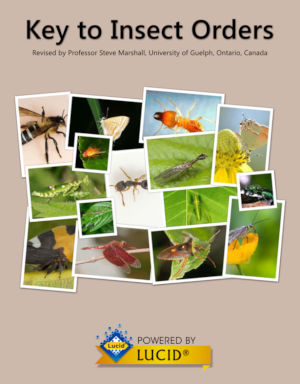
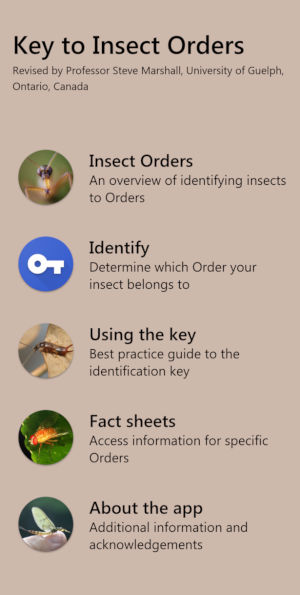
A key to Insect Orders, originally developed at The University of Queensland, has recently been revised by Prof Steve Marshall (University of Guelph, Ontario) and now deployed as an app on the latest, upgraded Lucid Mobile platform. It is available as an Android and iOS version for $ 1.99 from Google and iTunes.
The mobile application is available from the Google Play Store and Apple iTunes.
Lepidopteran Families of Biosecurity concern – updated
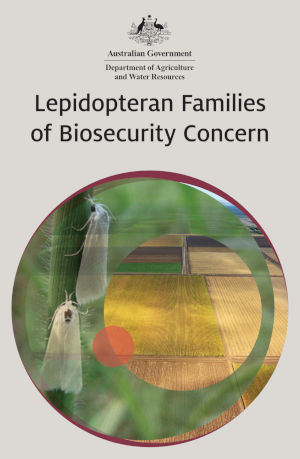
An update of this interactive lucid key that assists in recognising families of targeted Lepidoptera of biosecurity concern using morphological characters of the adult.
Many existing keys to adult Lepidoptera lack good illustrations of the important characters and this key provides high quality photographs of all the characters used. Easily identifiable features that are visible on set specimens using a stereomicroscope have been chosen in an attempt to avoid where possible, the type of characters requiring manipulation or dissection of the specimen for example, wing venation, apodemes and genitalia.
Authors: Anderson SJ, Luo YY & Bellis GA (2017). Lepidopteran Families of Biosecurity Concern. Interactive Lucid Key. Northern Australian Quarantine Strategy, Department of Agriculture and Water Resources
Plants of South Eastern New South Wales – App and website
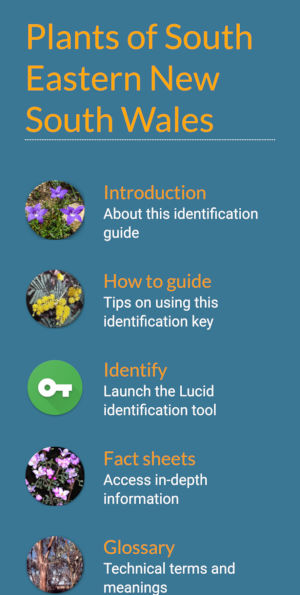
A sister key to Plants and Fungi of South Western New South Wales.
This key is designed for anyone who has an interest in finding out about the plants of south eastern New South Wales. It includes about 2,900 species of plants accompanied by about 10,000 images. It includes Eucalypts, but not ferns, orchids, grasses, or most sedges or rushes. There are about 3,900 relevant species in the area covered by this key.
The key mostly uses easily seen characters and a minimum of technical terms to help with the identification of plants. It is not designed to key out to a single species, though sometimes it does. It is designed to narrow down the possibilities of what the plant might be to a limited number of species. Images may then help you decide what your plant is.
In most cases, the use of a hand lens or a low power microscope is not necessary for identification, except when counting the number of flowers/florets in a flower head, and deciding whether hairs on stems are stellate (multiple hairs arising from a point, looking like a star), branched, or simple. Identification needing the use of a high power microscope is beyond the scope of the key.
Pacific Pests and Pathogens version 7 released
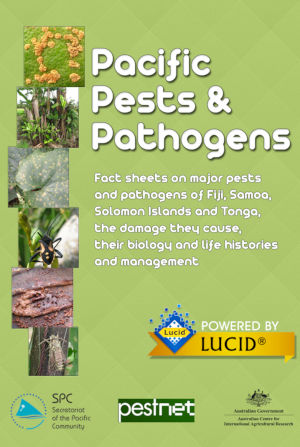
This latest update includes an additional 50 pests and pathogens (bringing the total to 401) along with more crops covered.
This edition now includes a web edition of the key.
Chikanda Orchid identification key
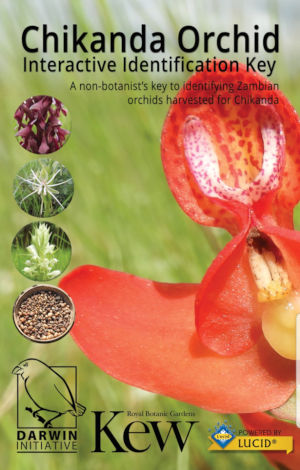
Chikanda is a local foodstuff from northern Zambia and surrounding countries. It is made from pounded groundnuts and the tubers of a number of orchid species. This identification app is targeted at non-botanists and involving the analysis of various features of the plant(s) and its habitat to help narrow down the choice of 63 species. As a result, it is not an exact key and will not necessarily narrow down the choices to the particular species but rather to a choice of a few of the most likely species.
Key to willow species and hybrids present in New Zealand
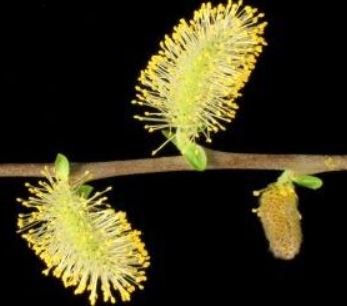
This key is illustrated with more than 2000 images of willow species and hybrids that are either wild or in cultivation in New Zealand, and the features that are used to identify them. Most illustrations are of willow clones grown in the national willow collection in Palmerston North maintained by Plant and Food NZ.
The key is designed for those with some experience in plant identification, and some features will need at least a strong hand lens (10x or better) to see features such as stamen filament hairs. It will be of use to bee-keepers, farmers with an interest in growing willows as bee food, and conservation estate managers who need to identify willows in the wild.
Writing of this key was funded by the Sustainable Farming Fund, Trees for Bees NZ, the Willow and Poplar Trust, Plant and Food NZ, and Manaaki Whenua - Landcare Research.
Authors: Glenny D, Jones T.
Spotlight on a new Seed Identification website
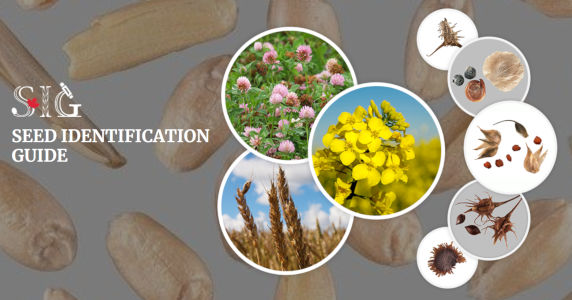
A website (https://www.idseed.org/) has recently been launched by the International Seed Morphology Association to “promote collaboration, knowledge sharing, resource development, and research among those who are interested in seed morphology and seed identification”.
The site provides information on various resources, including a Seed Identification Guide currently consisting of Seed identification fact sheets for 127 species, a searchable image gallery, botany glossary, Lucid seed identification keys, links to two online keys. https://www.idseed.org/seedidguide/home.html).
The website also provides resources for authors who are interested in developing and publishing seed identification factsheets or images, including protocols, template and standard feature descriptions. See more at https://www.idseed.org/authors.html. We welcome authors and collaborators to enrich the resources and the Seed Identification Guide for end users.
Both seed keys are Lucid keys: one key is to 36 common plant families, where a family identification is needed for an unknown seed or fruit. The following feature descriptors are used: Seed shape, Colour, Surface features, Hilum-Attachment scar, Size (Length/Diameter range).
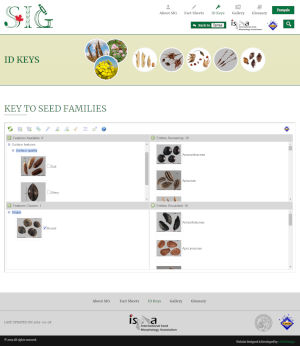
The other key is to the propagules or fruits of 102 biosecurity-relevant species of the daisy or sunflower family Asteraceae. It was produced by CSIRO scientist Alexander Schmidt-Lebuhn at the Australian National Herbarium (CANB) in collaboration with and through funding from the Department of Agriculture and Water Resources.
https://www.idseed.org/seedidguide/keys/details/Use-the-Fabaceae-key-if.html
Addendum to Q-Bank plant key spotlight article

In a previous Newsletter (October 2018), (October 2018 newsletter) the spotlight article focussed on Q-Bank, an invasive plants database that provides detailed species-level information on all plants species on the European Union list of EU concern. In this article we provided a list of Q-Bank keys to invasive plant species that are currently available but did not provide links to these online keys. We have rectified this in the list below [Note: You need to click on the language button to open up the appropriate language version]
- Weeds in imported pot plants in Europe - https://keys.lucidcentral.org/keys/v3/bonsai/
- Invasive terrestrial plants in Europe - https://keys.lucidcentral.org/keys/v3/invasive_terrestric_plants/
- Invasive aquatic plants - https://keys.lucidcentral.org/keys/v3/aquatic_plants/
- Seedlings of invasive plants - https://keys.lucidcentral.org/keys/v3/invasive_seedlings/
- Seeds of invasive plants - https://keys.lucidcentral.org/keys/v3/invasive_seeds/
- Pennisetum cultivars - https://keys.lucidcentral.org/keys/v3/pennisetum/
Lucid and Fact Sheet Fusion News
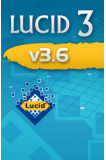 Lucid v3.6 Updated
Lucid v3.6 Updated
A new Lucid v3.6 update is now available. It adds additional features and corrects several minor bugs. Changes include:
Lucid JavaScript (Browser) Player
- New auto unprune option.
- Fixed bug preventing manual discard in the application player.
Lucid Builder
- Major updates to numeric input dialog, and improvements to the process for entering numeric data.
- Enhancements to the file export process, extension automatically appended based on export type, and changes to the way last paths are remembered.
- Fixed bug saving natural language template, which prevented descriptions from being output.
- Added menu option to recreate descriptions attached to the key if the template, structure or scoring has changed.
Click here to download the latest update - login required
To purchase Lucid click here.
 Fact Sheet Fusion
Fact Sheet Fusion
A new update to Fact Sheet Fusion (v2.0.5.132) is now available (free to existing v2 licence holders).
This update includes:
New features and enhancements
- The main forms (Main interface, Glossary manager, Media manger and Image viewer) now save and reload their position, size and layout between openings.
- The Image Viewer now allows you to move between the images contained within the selected media category.
- Added the selected media category to the Media manager title when selected.
- Extended the CSV export/import to include additional image properties.
- Updated the help.
Fixes
- Fixed a bug within the HTML editor where highlighted text, via a double click action, would not allow the text to be overwritten or deleted while highlighted.
- Fixed an exception that occurred when deleting a media category due to a save action on a non-existant image.
- Fixed a scrolling issue where the drag action ended outside the scope of a list box (entities, media categories). The scroll would continue within the list box, even when the drag and drop operation was abandoned.
Click here to download the latest update - login required
To purchase Fact Sheet Fusion click here.